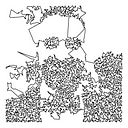E sì che uno come lui, dopo aver vissuto tanti anni in Italia, avrebbe dovuto rendersi conto che la bellezza non può essere programmata, essendo sempre l’effetto secondario di altre ricerche, spesso molto normali. Fondamenta degli Incurabili — Iosif Brodskij

InC is a tribute to the musical piece In C composed by Terry Riley in 1964. The piece is a series of short melodic fragments, composed for an indefinite number of performers, often cited as the first minimalist composition.
InC is my first project for Art Blocks. In fact, it’s the second! I met Erick Calderon during a hot summer in 2018. He told me about his idea of creating a place to explore creativity with generative design. Those were the early times of crypto art, when a few pioneering artists were just scratching the surface of art on blockchain, while few brave collectors were spending few dollars to purchase pieces worth millions now. SuperRare and KnownOrigin were just born, and the only things you could tokenize (as fungible tokens!) were static or animated images. I immediately liked Erick’s idea and his contagious enthusiasm. At the end of the summer, I had coded one of the first examples of artworks fully determined by a hash string: HashCoil. I still remember the comment of my girlfriend when I explained to her the machinery: Well, it’s a crypto peep show!
But the times were not mature for this sophisticated idea of digital art as a performance. Erick’s idea did not take off (but later it skyrocketed!) and I recycled the work with another name — Coilgram — which is now one of my most popular series.

Technically, InC is an interactive sketch originally written in Processing and then mapped into p5.js. You can play with it and review its code on OpenProcessing. The idea for the sketch came to me when I saw the works of Giorgia Fincato, a traditional painter from Italy.



When I met Giorgia, during a Cantieri workshop in Bassano del Grappa, I immediately asked her “Are you a generative artists?” hoping I had found a new generative fellow. She answered surprised: “What is generative art?”. I later discovered that Giorgia makes all her artworks with paper and pen, following only her mysterious intuition, during a sort of meditation in which she never blinks. I challenged her saying I could make a program that paints in the same way — indeed, my conjecture is that she’s following generative rules when drawing without being aware of it. So, during this last summer (summer is my coding season!), I spent quite some time trying to code her style. The outcome was impressive (I recall Giorgia was initially shocked). Then I tuned the code to move away from her style: InC was born!
Algorithmically, InC implements a random walk through the canvas. It starts from the center of the canvas and moves away randomly, with steps of different lengths. Eventually, the surfer is teleported into a new position of the canvas, from which the walk continues (here I took inspiration from the teleporting of a Web surfer coded in the PageRank algorithm used by Google Search engine). The surfer witnesses its passage by drawing lines, triangles, and (Bezier) curves, possibly filling them with a couple of complementary colors. The backgrounds are 99% black, but the lucky ones will have a white background. The outcome is a series of short design fragments, composed for an indefinite number of performers, much like the original In C composition by Terry Riley.
The code is in principle very simple, but I spent a good share of time tuning the parameters and probabilities to obtain a generator of results that are both visually interesting and diverse among each others.




All in all, InC is my little and humble contribution to beauty, in the hope that Fëdor was right.
Beauty will save the world — Fëdor Dostoevskij
